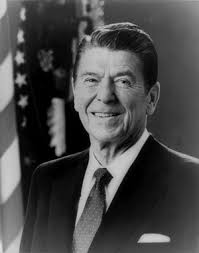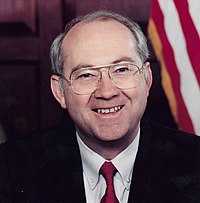
 In 1971, Richard Nixon floated the dollar in order to raise money to pay for the War in Viet Nam. Prior to that, we had remained on the Gold Standard even though one could not retrieve gold for currency. But it was the election of Ronald Reagan in 1980 that began the full scale assault on F.D.R.’s regulatory policies – and his economics in general. Reagan’s economics [called Reaganomics] were neither clear to me then nor now, but I know what he did. He cut taxes for the upper income brackets and eliminated a lot of other taxes that primarily affected the rich and businesses. He spent heavily on the Military. So he began running up the national debt as a result of decreased revenue and increased spending. He preached Deregulation. Here are a few highlights:
In 1971, Richard Nixon floated the dollar in order to raise money to pay for the War in Viet Nam. Prior to that, we had remained on the Gold Standard even though one could not retrieve gold for currency. But it was the election of Ronald Reagan in 1980 that began the full scale assault on F.D.R.’s regulatory policies – and his economics in general. Reagan’s economics [called Reaganomics] were neither clear to me then nor now, but I know what he did. He cut taxes for the upper income brackets and eliminated a lot of other taxes that primarily affected the rich and businesses. He spent heavily on the Military. So he began running up the national debt as a result of decreased revenue and increased spending. He preached Deregulation. Here are a few highlights:
- Banks were allowed to merge.
- It removed the power of the Federal Reserve to set the interest rates of savings accounts.
- It allowed credit unions and savings and loans to offer checkable accounts.
- Allowed institutions to charge any interest rates they choose.
"This Reagan Administration initiative is designed to complete the process of giving expanded powers to federally chartered S&Ls and enables them to diversify their activities with the view of increasing profits. Major provisions include: elimination of deposit interest rate ceilings; elimination of the previous statutory limit on loan to value ratio; and expansion of the asset powers of federal S&Ls by permitting up to 40% of assets in commercial mortgages, up to 30% of assets in consumer loans, up to 10% of assets in commercial loans, and up to 10% of assets in commercial leases."
Thank you all very much, and thank you for joining us to sign this historic reform. This bill is the most important legislation for financial institutions in the last 50 years. It provides a long-term solution for troubled thrift institutions…Now, this bill also represents the first step in our administration’s comprehensive program of financial deregulation…
What this legislation does is expand the powers of thrift institutions by permitting the industry to make commercial loans and increase their consumer lending. It reduces their exposure to changes in the housing market and in interest rate levels. This in turn will make the thrift industry a stronger, more effective force in financing housing for millions of Americans in the years to come…
The savings and loan crisis of the 1980s and 1990s (commonly referred to as the S&L crisis) was the failure of 747 savings and loan associations (S&Ls) in the United States. The ultimate cost of the crisis is estimated to have totaled around $160.1 billion, about $124.6 billion of which was directly paid for by the U.S. government—that is, the U.S. taxpayer, either directly or through charges on their savings and loan accounts—which contributed to the large budget deficits of the early 1990s. The concomitant slowdown in the finance industry and the real estate market may have been a contributing cause of the 1990–1991 economic recession. Between 1986 and 1991, the number of new homes constructed per year dropped from 1.8 million to 1 million, the lowest rate since World War II.
The Gramm-Leach-Bliley Act … is an Act of the United States Congress which repealed part of the Glass-Steagall Act of 1933, opening up competition among banks, securities companies and insurance companies. The Glass-Steagall Act prohibited a bank from offering investment, commercial banking, and insurance services.
The Gramm-Leach-Bliley Act (GLBA) allowed commercial and investment banks to consolidate. For example, Citibank merged with Travelers Group, an insurance company, and in 1998 formed the conglomerate Citigroup, a corporation combining banking and insurance underwriting services under brands including Smith-Barney, Shearson, Primerica and Travelers Insurance Corporation. This combination, announced in 1993 and finalized in 1994, would have violated the Glass-Steagall Act and the Bank Holding Company Act by combining insurance and securities companies, if not for a temporary waiver process. The law was passed to legalize these mergers on a permanent basis. Historically, the combined industry has been known as the financial services industry.
The Commodity Futures Modernization Act of 2000 … is United States federal legislation which repealed the Shad-Johnson jurisdictional accord, which had banned single-stock futures in 1982. The legislation also provided certainty that products offered by banking institutions would not be regulated as futures contracts.This act was incorporated by reference into H.R. 4577, an omnibus spending bill. It was passed by the 106th United States Congress and signed by President Bill Clinton on December 21, 2000…
The act has been cited as a public-policy decision significantly contributing to Enron’s bankruptcy in 2001 and the much broader liquidity crisis of September 2008 that led to the bankruptcy filing of Lehman Brothers and emergency Federal Reserve Bank loans to American International Groupand to the creation of the U.S. Emergency Economic Stabilization fund.
The "Commodity Futures Modernization Act of 2000" was introduced in the House on Dec. 14, 2000 … and never debated in the House. The companion bill was introduced in the Senate on Dec. 15th, 2000 (The last day before Christmas holiday) … and never debated in the Senate.Given the above-stated chronology, it would appear that the House and Senate versions of the bill were introduced just prior to the Christmas holiday in December of 2000, following George W Bush’s (first) election (in November of 2000), while then-President Clinton was serving out his final days as President. The bill was never debated by the House or Senate. The bill by-passed the substantive policy committees in both the House and the Senate so that there were neither hearings nor opportunities for recorded committee votes. In substance, it appears that the leadership of the Republican-controlled Senate and House incorporated the deregulation of credit default swaps into an omnibus budget bill at a time when the outgoing president was in no position to veto anything. The following article suggests that Bill Clinton and Alan Greenspan endorsed this law The Bet That Blew Up Wall Street though Clinton’s position in 2000 is only suggested, not confirmed or made clear in the report…
The Commodity Futures Modernization Act of 2000 has received criticism for the so-called "Enron loophole," which exempts most over-the-counter energy trades and trading on electronic energy commodity markets. The "loophole" was drafted by lobbyists for Enron working with senator Phil Gramm seeking a deregulated atmosphere for their new experiment, "Enron On-line."
 It’s hard to follow, but what it means is that Banks could bundle all kinds of things [like Mortgages] together and trade the packages – essentially giving away the risk that "kept them honest." This was the real cause of the whole financial crisis we’re in right now. Banks bundled loans, Insurance on loans, and many other things and sold them as assets – completely unregulated – as Commodities. Except they were only Commodities if they were paid off, which they weren’t. So the cascade of defaulted Mortgages and their risk had long ago left the lending institution and were floating around the world as "derivitives." In eight short years,
It’s hard to follow, but what it means is that Banks could bundle all kinds of things [like Mortgages] together and trade the packages – essentially giving away the risk that "kept them honest." This was the real cause of the whole financial crisis we’re in right now. Banks bundled loans, Insurance on loans, and many other things and sold them as assets – completely unregulated – as Commodities. Except they were only Commodities if they were paid off, which they weren’t. So the cascade of defaulted Mortgages and their risk had long ago left the lending institution and were floating around the world as "derivitives." In eight short years,  these mostly worthless packages totalled three times the world’s wealth. So when the housing bubble they helped create crashed, their worth disappeared. If that weren’t enough, Enron wrote its own clause in that deregulated Energy trading, and then they proceeded to trade away billions before going belly-up [Phil Gramm’s wife was on the Board of Enron]. Two financial crises in one Bill snuck through Congress during the Christmas Holiday [between Presidents]. This is the value that disappeared from the Stock Market, crashed the Banks, and has lead us to a financial crisis of unimaginable proportions.
these mostly worthless packages totalled three times the world’s wealth. So when the housing bubble they helped create crashed, their worth disappeared. If that weren’t enough, Enron wrote its own clause in that deregulated Energy trading, and then they proceeded to trade away billions before going belly-up [Phil Gramm’s wife was on the Board of Enron]. Two financial crises in one Bill snuck through Congress during the Christmas Holiday [between Presidents]. This is the value that disappeared from the Stock Market, crashed the Banks, and has lead us to a financial crisis of unimaginable proportions.
Mickey, thank you for this series on the depression and deregulation. You have applied the clarity and common sense thinking I have always valued in your psychoanalytic explanations. These essays should be bound and published as a primer for those of us who want to understand what’s happening without having to wade through all the technical jargon.
I glean two simple lessons about the economy and “free markets” from this:
1. Any system that lets people get rich by investing in loss is ultimately going to fail. It should be self-evident: if you can get rich by investing in others’ loss without taking any risk yourself, then it’s going to encourage loss rather than success.
2. The ultimate result of deregulation and de-firewall-ization is the creation of financial institutions that become “too big to fail.” Then the taxpayers have to bail them out in order to save the economy. Without these enabling measures, the market would punish those that take too much risk, small institutions would fail, and other would learn the lesson
Instead, the loss-swap measures and the conglomeration of financial institutions kept the market from working to self-correct. I’m not advocating total free markets, because I think that ignores humanistic concerns that a humane society needs to insure. But we had a hybrid monster that pretended to be freeing up the markets while also protecting them both from regulation and from self-correcting forces.
I don’t need a PhD in economics to know that’s a formula for ultimate disaster.
[…] looking back – the Deregulation I… […]
[…] looking back – the Deregulation I… […]